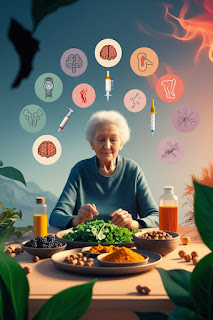Exploring the Safety of High-Bioavailability Curcumin Supplements Versus Traditional Turmeric Use
BY BRIAN S.
Curcumin is hailed for its anti-inflammatory benefits, but can piperine-enhanced supplements cause liver toxicity? Discover the science behind turmeric, bioavailability, and hepatotoxicity risk.
Turmeric (Curcuma longa) has been revered in traditional medicine for centuries, especially in systems such as Ayurveda and Jamu. Its main active component, curcumin, is known for potent anti-inflammatory and antioxidant properties. However, the modern supplement industry has isolated curcumin and combined it with piperine (from black pepper) to improve its notoriously low bioavailability. While this may seem like a win for effectiveness, emerging evidence suggests it could come with unintended risks—including hepatotoxicity.
The Hepatotoxicity Issue: Real but Reversible
A number of recent case reports have shown that some individuals develop drug-induced liver injury (DILI) from high-dose curcumin supplementation, especially when taken with piperine. Symptoms often include jaundice, elevated liver enzymes, and fatigue, but fortunately, these effects appear to be reversible upon discontinuation of the supplement.
For example, Lukefahr et al. (2020) reviewed several cases of liver injury linked to curcumin-piperine combinations. These individuals had no prior liver disease and recovered fully after stopping supplementation.
The Role of Piperine in Liver Toxicity
Piperine plays a double-edged role. While it enhances curcumin absorption by up to 2000% (Shoba et al., 1998), it does so by inhibiting key liver enzymes, namely CYP3A4 and UGT (UDP-glucuronosyltransferase). These enzymes are critical for metabolizing curcumin and detoxifying many drugs. By blocking them, piperine can cause curcumin (and possibly other substances) to accumulate in the liver, potentially leading to oxidative stress and toxicity.
This becomes particularly concerning when curcumin is consumed in doses far exceeding traditional dietary intake.
🌿 Whole Turmeric: A Safer, Synergistic Alternative?
Contrast this with whole turmeric powder, which contains not only curcuminoids but also essential oils, polysaccharides, and natural compounds that may buffer and balance curcumin’s effects. Traditional use of turmeric in diets—up to 1 teaspoon three times daily over years—has not been associated with jaundice or liver dysfunction in anecdotal or ethnomedical records.
This underscores a key principle: whole herbs often operate within a safety buffer that isolated compounds do not.
⚖️ A Comparative Look: Whole Turmeric vs. Curcumin Supplement
| Feature | Whole Turmeric | Curcumin + Piperine |
|---|---|---|
| Bioavailability | Low | Very high |
| Synergistic compounds | Present | Lacking |
| Safety record | Long-term, favorable | Limited, concerns exist |
| Mechanism | Holistic, food-like | Drug-like, potent |
| Liver risk | Very low | Moderate (idiosyncratic) |
Curcumin in piperine-enhanced form behaves pharmacologically like a modern drug, bypassing many of the body’s natural metabolic checkpoints. While this may be ideal for acute inflammation or targeted therapeutic use, it also increases the risk of liver burden, particularly in people with pre-existing liver conditions, genetic variations in CYP450 enzymes, or those on multiple medications.
In essence, when curcumin is taken in isolation and concentrated form, we are no longer dealing with food, but with a powerful bioactive substance—one that needs to be treated with the same caution as pharmaceuticals.
✅ Conclusion: Therapeutic Wisdom from Nature
While high-bioavailability curcumin may have its place in short-term therapy, it is crucial to respect the boundaries of traditional herbal wisdom. Whole turmeric—used with food or in simple teas—offers a safer long-term strategy with a more favorable safety profile.
If choosing a supplement, opt for formulations without piperine, or those that use phospholipid-based delivery systems (like Meriva®) which may offer enhanced absorption without enzyme inhibition.
As modern science continues to validate ancient remedies, it also reminds us: more is not always better—especially when nature has already provided a safe template for healing.
📚 References
Lukefahr, A. L., McGill, M. R., Tandri, H. and Bourgeois, J. A., 2020. Hepatotoxicity associated with curcumin supplementation: A systematic review and meta-analysis. The American Journal of Medicine, 133(11), pp.1388–1393.
Nelson, K. M., Dahlin, J. L., Bisson, J., Graham, J., Pauli, G. F. and Walters, M. A., 2017. The essential medicinal chemistry of curcumin. Journal of Medicinal Chemistry, 60(5), pp.1620–1637.
Shoba, G., Joy, D., Joseph, T., Majeed, M., Rajendran, R. and Srinivas, P. S., 1998. Influence of piperine on the pharmacokinetics of curcumin in animals and human volunteers. Planta Medica, 64(4), pp.353–356.
Copyright © 2025 www.zentnutri.blogspot.com. All Rights Reserved.












